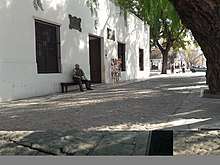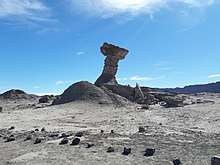San Juan (city, Argentina)
San Juan is the capital city of San Juan province, in the central-west Cuyo region of Argentina.
Understand
The city of San Juan is located in a fertile valley within a rocky mountainous area. Winter temperatures are generally mild, between 1 °C and 18 °C, while summers are hot and very dry, with temperatures between 25 °C and 40 °C.
Since very little rain falls in the region, the San Juan River has been dammed to provide a regular source of water to the city. The resulting reservoir is in Ullum, and is known as the Quebrada de Ullum Dam. The dam also provides electrical power to the region.
Sixty-five percent of agricultural production is related to wine production.
Get in
Public transport long distance is addressed in the modern bus terminal. Holds hall waiting for the local administration, ticketing, information office, police, first-aid room, telephone booths, shops, restaurant, kitchen and sanitary.
Domingo Faustino Sarmiento Airport is 15 km from the city in the Department 9 de Julio, in the village of Las Chacritas. It is at coordinates 31°34'18.70"S, 68°25'23.00"O. (UAQ IATA). This airport serves the airlift from San Juan was the city of Buenos Aires.
The city lies on National Route 40 that connects it with Mendoza (168 km) to the south and La Rioja (449 km) to the north, and is connected to the National Route 20, that leads to San Luis (323 km). Distance to other cities: Córdoba (585 km), Catamarca (623 km) and Buenos Aires (1110 km).
Get around
The city has a modern infrastructure such as highways Avenue Beltway, and the South Access among others. This avenue has been within the urban perimeter, which is why a project is the construction of another ring covering the entire city. This might be termed as the Orbital motorway or dual carriageway, and that his movement will take the form surrounding the Great San Juan, as an orbit, preventing access by large trucks carrying inside the city. It also calls for tenders for the project through another rapid called South Corridor connecting San Juan (center) with the southern suburbs.
The urban public transport passengers from the City of San Juan consists of bus lines marked with numbers and letters (19 or 26A), linking the city centre with the various neighbourhoods and the rest of the Great San Juan. The city also has taxi service and remises.
The city is within the Capital District, the plot of the same one is developed in form of draws into squares checkerboard forming a boundary by the streets Las Heras (that runs from North to South), 25 de Mayo (runs from East to West), 9 de Julio (runs from east to west) and the Guillermo Rawson Avenue (runs from north to south). These four avenues form a perfect rectangle made up of 16 blocks wide (going from east to west and vice versa -horizontally-) by 10 blocks long (going up and down or North to South and vice versa). This rectangle, in its interior conforms a square of 7 blocks of length by 6 blocks of wide, that is "microcentro", delimited by four avenues and are the Avenue Leandro N. Alem, Cordoba Avenue, Avenue Libertador San Martín and Avenida Rioja. This area is considered to be the most densely populated and possess a great amount of tall buildings; it concentrates most of the commercial, financial and institutional activities.
The most important east/west streets are Mitre, Central Jose Ignacio de la Rosa, Santa Fe, Rivadavia, and Libertador San Martin. Mitre runs Eastbound, and features cyber cafes and movie theaters. The Central Avenue was built after the 1944 earthquake, and it runs both ways without a boulevard. Santa Fe runs Westbount, has a lot of bus lines through it and shows much commercial activity. Rivadavia, running westbound, also has much commercial activity with the two blocks between Rioja and General Acha transformed into a pedestrian mall. Libertador San Martín Avenue, running west-east in both directions, has a boulevard; traffic is intense with multiple public bus lines using it for their main cross town route.
The most important north-south streets are Entre Rios (northbound), Mendoza (southbound), General Acha (northbound), and the Avenida Rioja (north-south with boulevard). All connect the city with the north and south suburbs.
See
- 🌍 Catedral Arquidiocesana San Juan Bautista (Metropolitan Cathedral), cnr of Rivadavia Oeste and Mendoza Sur (in front of main square 25 de Mayo), ☎ +54 264 422-7050, e-mail: catedralsj@gmail.com. Built in 1979 after the 1944 earthquake seriously damaged the previous Jesuit church that had been erected as the Cathedral of San Juan. A work of prestigious architect Daniel Ramos Correas. The bell tower is 51 meters high, covered with red ceramic brick and topped with an ornamental pyramid. An elevator goes up to a viewpoint at the top. It has a Big-Ben clock and a German carillon that rings every 15 minutes. The main nave is accessed through a bronze vestibule built in Faenza, Italy with bas-relief of Santa Rosa de Lima, San Luis, the Santiago apostle, Santa Ana and several other shields and emblems. In the basement of the church is a crypt, tombs of former bishops and a chapel of famous argentine bishop and San Juan-born Justo de Santa María de Oro. free.
- Peatonal Tucumán and Rivadavia. The most important strolls of the city, where the commercial activity is mostly concentrated. They are wide, nicely decorated with trees and other motifs, is most-go for the sanjuaninos and tourists alike.
- Parque de Mayo (Park of May). In May 1910, when commemorating the centenary of the May Revolution, this green space is inaugurated. This lung of the city is in the intersection of the streets General San Martín and Heras. It has games for children, an artificial lake with an island, fish and aquatic birds, a cycling circuit, karting facilities and lots of statues.
- Casa Domingo Faustino Sarmiento (Domingo F. Sarmiento’s native house, Argentine hero). Located in the intersection of Libertador General San Martín Avenue and Sarmiento street. It was the first historical monument declared in the country, in 1910. In this house it was born the illustrious educator and president of the republic, Domingo Faustino Sarmiento, 15 February 1811. It has 9 rooms, in which relics, furniture, commemorative photographies, medals, periodics and books written by Sarmiento in its original collections, can be admired. In the central patio of the house one can find a sprout of the famous fig tree and a replica of the historical loom of Doña Paula, his mother, whom Sarmiento mentions in his book "Recuerdos de Provincia".
 Domingo Faustino Sariento's house
Domingo Faustino Sariento's house - Seat 25 of May. The main seat of the city, it constitutes a green space of colorful characteristics, also are the statues of Domingo Faustino Sarmiento and Right Fray Santa Maria de Oro with more than 100 years. The central source, that dates from year 1871, was remodelada in several occasions. The toads extractors are work of the escultor Miguel Sugo Angel.
- Aberastain seat. He was lawyer and he was Governor of the province. This seat this taken care of very well and is characterized by its permanent hygiene and in the center is the statue of Aberastain.
- Museum of Fine arts Franklin Rawson - Historical Provincial Museum Agustín Gnecco. Located in the intersection of General Paz street and G. Rawson Avenue. There one finds a valuable patrimony of paintings and sculptures, engravings and drawings of the greatest national masters. In the second one are outlined elements related to the fashion of the XVIIIth and XIXth century, Creole silverwork(silver), collection of numismatics and philately.
- Museum Amid Read - House of the Tango Carlos Gardel. This museum is on General Mariano Acha street between Brazil and Manuel Belgrano streets, with displays and videos about the tango and its evolution in the 20th century. Conferences, discussions, classes of Violin and Bandoneón are among the activities conducted here.
- Museo Santiago Graffigna, Colón 1342 norte (take the bus 12A from the center (calle Libertador/Tucuman)), ☎ +54 264 4214227. 09:0-17:30. Visit the 140-year-old Graffigna winery with a tasting at the end of the tour. free.
 San Guillermo National Park
San Guillermo National Park - Juan Victoria Auditorium Center
- El Leoncito National Park. An internationally recognized Observatory
- San Guillermo National Park and Provincial Reserve. Habitat of vicuñas and guanacos
- San José de Jáchal – Iglesianos Valley
- Cuesta del viento Dam
- Ullum Dam
- Alcázar Hill
- Solar eclipse of July 2, 2019. San Juan is one of the cities in the path of totality for this eclipse.
Do
Tourism to San Juan is centered around wine production and dégustation as well as the extraordinary rock formations in places like the Ischigualasto Provincial Park, 330 km form the city, also called the Valle de la Luna and the Quebrada de Ullum Dam, at 18 km from the city.

An integral attraction to the province is its large Triassic period fossil record, believed to be one of the largest in the world. Another curiosity is the Difunta Correa sanctuary, 64 km away from San Juan, on route 141.
There is also the celebrated Mariano Gambier Archeology museum at La Laja, Albardón county, some 25 km from the center of the city. It concerns itself with the many cultures that inhabited San Juan from Pre-History till the arrival of the Spaniards in 1560. It has a priceless collection of Indian artifacts, cave paintings and other elements of agriculture and life in the Tulum valley from the last 8500 years.
The city of San Juan completely changed its appearance from a colonial one to one of the most modern in the country after the earthquake of 1944, with well-drawn and wide paved streets, ample paths with mosaics, and forests of bananas, moreras and paradises irrigated by channels (small drains).
Buy
Eat
- Tabletas Sanjuaninas. This is the local version of "alfajor" (a national candy in Argentina). They can be purchased in local "panaderias" (bakeries) and some souvenir shops. They usually come in two varieties: with "Dulce de Leche" (milk caramel) or Dulce de Alcayote (a jam made of a local fruit).
Drink
Pedro Echague 520 (E)
This place is sweet, it's clean, cheap and everything else you need. More importantly the owner is one of the most kind, genuine people you could hope to meet.
Sleep
Go next
- Ischigualasto Provincial Park aka Moon Valley
- Barreal: a village up against the Andes Cordillera